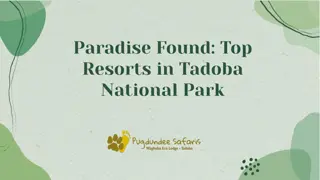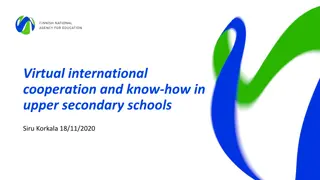*Redesigning ECO Sessions: Moving Towards the Upper Room*
Explore the transition from traditional session structures to a more spiritually focused approach in ECO sessions, aiming to nurture covenant partners and uphold mission values. The discussion highlights the shift from business-centered meetings to incorporating prayer, worship, and vision discussions, offering two models for restructuring session organization. Discover how these changes can align churches with ECO's mission and values, fostering spiritual growth and community engagement.
Download Presentation

Please find below an Image/Link to download the presentation.
The content on the website is provided AS IS for your information and personal use only. It may not be sold, licensed, or shared on other websites without obtaining consent from the author. Download presentation by click this link. If you encounter any issues during the download, it is possible that the publisher has removed the file from their server.
E N D
Presentation Transcript
From the Lower Room to the Upper Room: Redesigning an ECO Session Rev. Nate Dreesmann, Executive Director of Ecclesiastical Support
Moving from the Lower Room to the Upper Room What are ways a session may organize itself to live into ECO s values?
An ECO Session (What we strive for) This session shall strive to create an effective disciple- making, ministry-discernment process, and equip covenant partners to be missional Christians, being faithful to nurture covenant partners into spiritual maturity and significant ministry. o P-1.0305
A Typical Session? Typically, sessions are organized this way: o Open in prayer, brief devotional, consent agenda, clerk s report, committees/teams report, staff report, moderator s report, new business, and close in prayer. o Most of the meeting is spent on and around finance and very little on P-1.0305. What if a session, structured more like a boardroom, has inadvertently contributed to the problem of shrinking churches?
A Typical Session? What if the leadership, spending most of its time on business matters instead of spiritual matters, causes a church to take its eyes off the ball and miss the Holy Spirit? What change needs to occur if a church is to live into ECO s Mission and Values?
Moving from the Boardroom to the Upper Room What if your two-hour session meeting looked like this? o 30 minutes on business items o 45 minutes in prayer, study, and worship o 45 minutes on vision and big picture items
Two Models: 50% Approach and 100% Approach As a session is moving from the boardroom to the upper room, it requires a restructuring of how the session is organized and does its business. ECO is encouraging this restructuring to look like the 100% model. However, this model would lead to a great deal of change for a church and session. The 50% approach sets a pathway for a church that takes a steadier approach to the Upper Room . The model is based in part on John Carver s Boards that make a difference and John Kaiser s Winning on Purpose.
Living out ECO Values in our structures: 30 Minutes of Business (50%) All ministry teams write up reports and submit at least one week before the session meeting, so that elders may ask their questions directly to the elder who is leading a particular area of the church. When a budget, more aptly called a Spending Plan , is approved, each department manages their line-items. o The session only needs consultations for items that need funding outside the budget/spending plan or if cut-backs need to be made across the board.
Living out ECO Values in our structures: 30 Minutes of Business (50%) When you welcome new covenant partners, this could happen outside of regular session meetings as an event dedicated to this important action. o It may be done by a commission of elders, though it is so encouraging to the body, a special meeting would be preferred. New business, unless an emergency, must be submitted at least a week in advance, should start in one of the ministry teams/committees, and come to the session with at least one committee/team recommendation.
Living out ECO Values in our structures: 30 Minutes of Business (50%) Challenges? o Many, especially smaller churches, have elders who want their say on every decision. o Many churches are not organized well or have leaders who miss deadlines regularly and the other elders or the moderator enables the behavior. o Churches are so small or discouraged that the session becomes a support group, rather than a spiritual leadership team. o Others?
Living out ECO Values in our structures: (100%) The organizational structure of the church shifts from session led teams to staff led teams. Staff is defined as paid or volunteer individuals who have job descriptions and are accountable to the Pastor/Head of Staff. The session of no more than 7 become the vision/mission team, spiritual leaders, and primarily holds the pastor accountable to executing the ministry that enables the congregation to live out its mission and vision.
Living out ECO Values in our structures: 30 Minutes of Business (100%) While some reporting may be done through a consent agenda (a way to group non-controversial items together and vote in one action), most of the business will come from the Pastor s report. The Pastor will seek approval for anything that is coming from his/her staff that is outside the budget/spending plan. The Pastor s report to the session, submitted at least a week in advance, will include updates in all areas of the church and how each month the staff is leading the congregation to live out the mission and vision that the session and pastor have agreed on. The session s primary responsibility is to lead the pastor and hold the pastor accountable to his/her established and agreed upon monthly, quarterly, and annual goals.
Session Meeting Outline Prayer and Business (may include dinner) The Moderator keeps the ball rolling. Committee/teams only verbally report on items that would require session action, which would be known to everyone ahead of time (50%). The Pastor covers any items that may need approval from the session that comes from any staff member (100%). This will mean the supermajority of items may be received by using a Consent Agenda.
A Possible Meeting Outline I would recommend all non-controversial action items or reports that need to be received go onto a consent agenda. o Consent agendas allow you to vote on a series of motions at one time, but also allows a member of session to pull any items before the vote. o There is no discussion on these items unless they are pulled by an elder. Most questions should have been asked directly to the elder/treasurer/staff ahead of time.
Study, Worship, Prayer (45 minutes) 50% or 100% A time of study (scripture/lesson) Pray specifically for the congregation, the elders, the community, and ECO A time of worship/singing Lord s Supper
Vision/Big Picture/Goals (45 minutes) 50% and 100% Vision/Big Picture Often a focus on one big picture item that moves the church closer to: o Its strategic goals o Living out mission o Living out vision After no more than 2 hours, close in prayer.
Ministry Teams of the Session (50%) Ministry Teams of the session may use some version of this model. o 45 Minutes Prayer/Worship o 45 Minutes Vision/Planning o 30 Minutes of Business/Action Items This model helps to create community within a team and greater connection to the mission/vision of the church.
Ministry Teams of the Session (100%) The Staff will create goals with the Pastor/Head of Staff to live out the Mission/Vision of the church in their area of influence. The Staff member will create the team they need to accomplish their approved goals. In this model, the staff member is the one who is always held accountable to the accomplishing their goals. A session member may serve on a team when invited by a staff member, but they serve as a team member, not as an elder in charge of this area . In some ECO churches, the Deacons have been recognized to serve as the volunteer staff leaders of the church.
Discussion Groups What about these models do you like and/or appreciate? What about these models would be hard to implement? In what ways can you more fully embrace this type of session meeting model?
ECO has given the framework to nurture Flourishing Leaders Mission Affinity Groups (MAG) o To learn from one another. o To pray for one another. o To be transparent and authentic before God and one another. Pastor Covenant Groups (PCG) o To pray for one another. o To learn from one another. o To be transparent and authentic before God and one another for personal and spiritual health.
DISCUSSION What are ways the presbytery and ECO can equip and assist you in the development of your ministry? What are ways that you and/or your church may contribute to the work of the presbytery?























